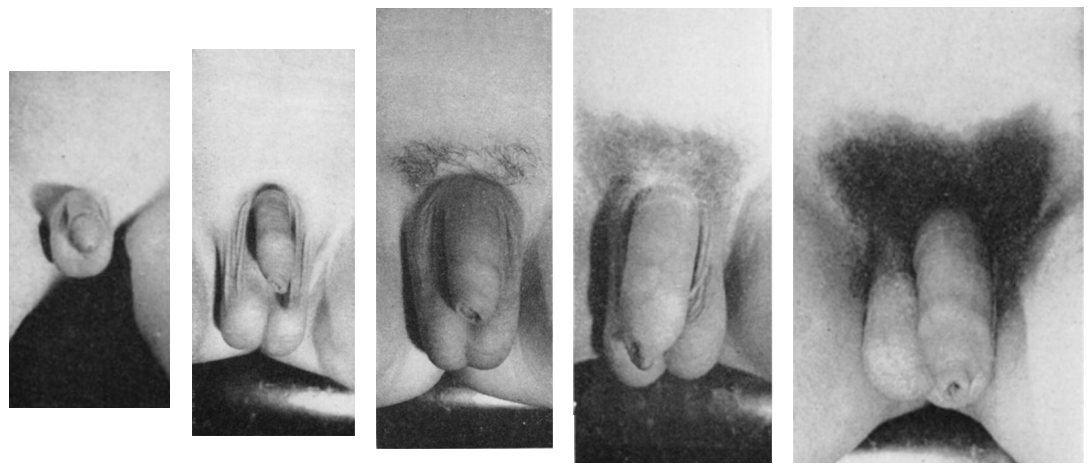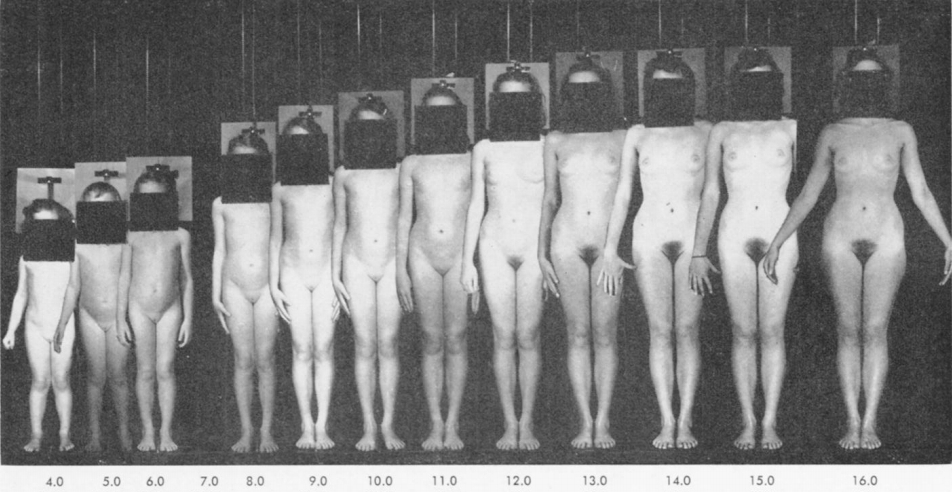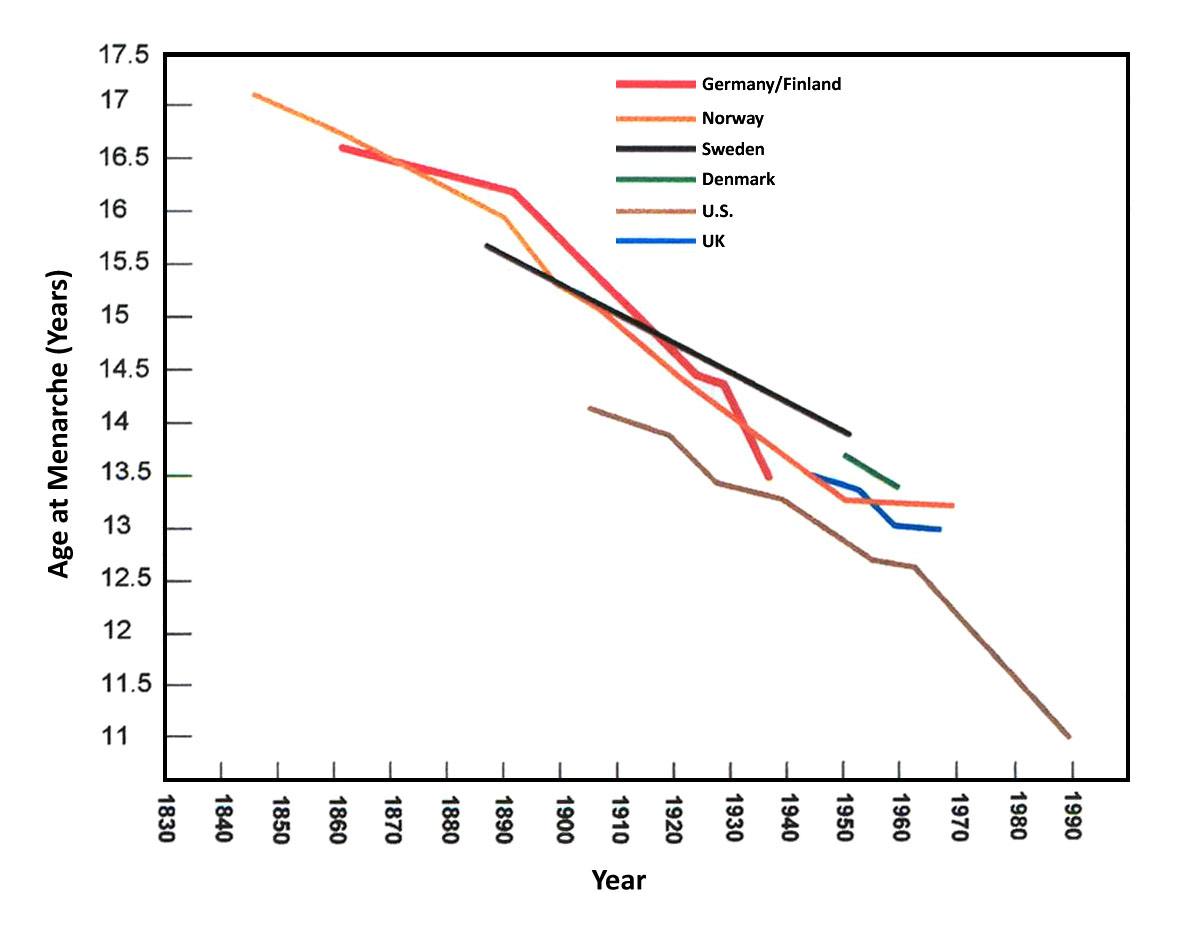|
Gonadarche
Gonadarche () refers to the earliest gonadal (reproductive gland) changes of puberty. In response to pituitary gonadotropins, the ovaries in females and the testes in males begin to grow and increase the production of the sex steroids, especially estradiol and testosterone. The ovary and testis have receptors, follicle cells and leydig cells, respectively, where gonadotropins bind to stimulate the maturation of the gonads and secretion of estrogen and testosterone. Certain disorders can result in changes to timing or nature of these processes. * In males, gonadarche is responsible for testicular enlargement and virilization. * In females, gonadarche is responsible for thelarche and menarche (first menstruation). Gonadarche should be contrasted with adrenarche. Gonadarche indicates that true central puberty has begun, while adrenarche is an independent maturational process only loosely associated with complete puberty. Physiology Puberty is influenced by a multitude of factors ... [...More Info...] [...Related Items...] OR: [Wikipedia] [Google] [Baidu] |
Puberty
Puberty is the process of physical changes through which a child's body matures into an adult body capable of sexual reproduction. It is initiated by hormonal signals from the brain to the gonads: the ovaries in a female, the testicles in a male. In response to the signals, the gonads produce hormones that stimulate libido and the growth, function, and transformation of the brain, bones, muscle, blood, skin, hair, breasts, and sex organs. Physical growth—height and weight—accelerates in the first half of puberty and is completed when an adult body has been developed. Before puberty, the external sex organs, known as primary sexual characteristics, are sex characteristics that distinguish males and females. Puberty leads to sexual dimorphism through the development of the secondary sex characteristics, which further distinguish the sexes. On average, females begin puberty at age 10½ and complete puberty at ages 15-17; males begin at ages 11½-12 and complete pube ... [...More Info...] [...Related Items...] OR: [Wikipedia] [Google] [Baidu] |
Pubarche
Pubarche () refers to the first appearance of pubic hair at puberty. It is one of the earliest physical changes of puberty and can occur independently of complete puberty. It is usually the second sign of puberty, after thelarche in females and gonadarche in males (though in females, it can also happen before thelarche, but this is less common). The early stage of sexual maturation, also known as adrenarche, is marked by characteristics including the development of pubic hair, Underarm hair, axillary hair, Body odor, adult apocrine body odor, acne, and increased oiliness of hair and skin. The Encyclopedia of Child and Adolescent Health corresponds SMR2 (sexual maturity rating) with pubarche, defining it as the development of pubic hair that occurs at a mean age of 11.6 years in females (range 9.3–13.9 years) and 12.6 years in males (range 10.7–14.5 years). It further describes that pubarche's physical manifestation is Vellus hair, vellus hair over the labia or the base of the pe ... [...More Info...] [...Related Items...] OR: [Wikipedia] [Google] [Baidu] |
Hypothalamic–pituitary–gonadal Axis
The hypothalamic–pituitary–gonadal axis (HPG axis, also known as the hypothalamic–pituitary–ovarian/testicular axis) refers to the hypothalamus, pituitary gland, and gonadal glands as if these individual endocrine glands were a single entity. Because these glands often act in concert, physiologists and endocrinologists find it convenient and descriptive to speak of them as a single system. The HPG axis plays a critical part in the development and regulation of a number of the body's systems, such as the reproductive and immune systems. Fluctuations in this axis cause changes in the hormones produced by each gland and have various local and systemic effects on the body. The axis controls development, reproduction, and aging in animals. Gonadotropin-releasing hormone (GnRH) is secreted from the hypothalamus by GnRH-expressing neurons. The anterior portion of the pituitary gland produces luteinizing hormone (LH) and follicle-stimulating hormone (FSH), and the gonads produ ... [...More Info...] [...Related Items...] OR: [Wikipedia] [Google] [Baidu] |
Gonad
A gonad, sex gland, or reproductive gland is a Heterocrine gland, mixed gland and sex organ that produces the gametes and sex hormones of an organism. Female reproductive cells are egg cells, and male reproductive cells are sperm. The male gonad, the testicle, produces sperm in the form of Spermatozoon, spermatozoa. The female gonad, the ovary, produces egg cells. Both of these gametes are haploid cells. Some hermaphroditic animals (and some humanssee Ovotesticular syndrome) have a type of gonad called an ovotestis. Evolution It is hard to find a common origin for gonads, but gonads most likely evolved independently several times. Regulation The gonads are controlled by luteinizing hormone (LH) and follicle-stimulating hormone (FSH), produced and secreted by gonadotropic cell, gonadotropes or gonadotrophins in the anterior pituitary gland. This secretion is regulated by gonadotropin-releasing hormone (GnRH) produced in the hypothalamus. Development The gonads develop f ... [...More Info...] [...Related Items...] OR: [Wikipedia] [Google] [Baidu] |
Developmental Stages
Stages of development may refer to: Biology *Developmental biology, the study of the process by which animals and plants grow and develop *Prenatal development, also called fetal development, or embryology *Human development (biology), the process of growing to maturity. In biological terms, this entails growth from a one-celled zygote to an adult human being Economics *Economic growth, the increase in the amount of the goods and services produced by an economy over time *Input-output model, a quantitative economic technique that represents the interdependencies between different branches of a national economy or different regional economies * IS/LM model, a macroeconomic tool that demonstrates the relationship between interest rates and real output in the goods and services market and the money market *Rostovian take-off model * Exogenous growth model *Endogenous growth theory, holds that economic growth is primarily the result of endogenous and not external forces * Dual-secto ... [...More Info...] [...Related Items...] OR: [Wikipedia] [Google] [Baidu] |
Developmental Biology
Developmental biology is the study of the process by which animals and plants grow and develop. Developmental biology also encompasses the biology of Regeneration (biology), regeneration, asexual reproduction, metamorphosis, and the growth and differentiation of stem cells in the adult organism. Perspectives The main processes involved in the embryogenesis, embryonic development of animals are: tissue patterning (via regional specification and patterned cellular differentiation, cell differentiation); tissue growth; and tissue morphogenesis. * Regional specification refers to the processes that create the spatial patterns in a ball or sheet of initially similar cells. This generally involves the action of cytoplasmic determinants, located within parts of the fertilized egg, and of inductive signals emitted from signaling centers in the embryo. The early stages of regional specification do not generate functional differentiated cells, but cell populations committed to developing ... [...More Info...] [...Related Items...] OR: [Wikipedia] [Google] [Baidu] |
Spermarche
Spermarche, also known as semenarche, is the time at which a male experiences his first ejaculation. It is considered to be the counterpart of menarche in females. Depending on upbringing, cultural differences, and prior sexual knowledge, males may have different reactions to spermarche, ranging from fear to excitement.''Adolescence and Emerging Adulthood: A Cultural Approach'', Jeffrey Jensen Arnett, N.J.: Prentice-Hall, 3rd edition, 2006. Spermarche is one of the first events in the life of a male leading to sexual maturity. It occurs at the time when the secondary sex characteristics are just beginning to develop. Researchers have had difficulty determining the onset of spermarche because it is reliant on self-reporting. Other methods to determine it have included the examination of urine samples to determine the presence of spermatozoa. The presence of sperm in urine is referred to as spermaturia. Age of occurrence Research on the subject has varied for the reasons stated a ... [...More Info...] [...Related Items...] OR: [Wikipedia] [Google] [Baidu] |
Menarche
Menarche ( ; ) is the first menstrual cycle, or first menstruation, menstrual bleeding, in female humans. From both social and medical perspectives, it is often considered the central event of female puberty, as it signals the possibility of fertility. Girls experience menarche at different ages, but the most common age is 12. Having menarche occur between the ages of 9–14 in the West is considered normal.US National Health Statistics Report September 2020 The timing of menarche is influenced by female biology, as well as Genetics, genetic, environmental factors, and nutritional factors. The mean age of menarche has declined over the last century, but the magnitude of the decline and the factors responsible remain subjects of contention. The worldwide average age of menarche is very difficult to estimate ... [...More Info...] [...Related Items...] OR: [Wikipedia] [Google] [Baidu] |
Thelarche
Thelarche, also known as breast budding, is the onset of secondary breast development, often representing the beginning of pubertal development. It is the stage at which male and female breasts differentiate due to variance in hormone levels; however, some males have a condition in which they develop breasts, termed gynecomastia. Thelarche typically occurs between the ages of 8 and 13 years with significant variation between individuals. However, the initial growth of breast tissue occurs during fetal development. It is usually the first sign of puberty in females (less commonly, it can be the second sign, after pubarche). Usually, females experience menarche about two years after thelarche has begun, with complete breast development from thelarche to adult breasts, taking between 2 and 4 years but can last up to age 18. Moreover, puberty is considered delayed if breast development does not start at age 13 or if a female has not had her first period (menarche) within three years of ... [...More Info...] [...Related Items...] OR: [Wikipedia] [Google] [Baidu] |
Adrenarche
Adrenarche is an early stage in sexual maturation that happens in some higher primates (including humans), typically peaks at around 20 years of age, and is involved in the development of pubic hair, body odor, skin oiliness#Oily skin, skin oiliness, axillary hair, sexual attraction/sexual desire/increased libido and mild acne. During adrenarche the adrenal glands secrete increased levels of weak adrenal androgens, including dehydroepiandrosterone (DHEA), dehydroepiandrosterone sulfate (DHEA-S), and androstenedione (A4), but without increased cortisol levels. Adrenarche is the result of the development of a new zone of the adrenal cortex, the zona reticularis. Adrenarche is a process related to puberty, but distinct from hypothalamic–pituitary–gonadal axis (HPG axis) maturation and function. Occurrence Adrenarche occurs starting at the age of 6 years. After the first year of life, the adrenal glands secrete very low levels of adrenal androgens. Adrenarche begins on avera ... [...More Info...] [...Related Items...] OR: [Wikipedia] [Google] [Baidu] |
Anti-Müllerian Hormone
Anti-Müllerian hormone (AMH), also known as Müllerian-inhibiting hormone (MIH), is a glycoprotein hormone structurally related to Activin and inhibin, inhibin and activin from the transforming growth factor beta superfamily, whose key roles are in growth differentiation and folliculogenesis. In humans, it is encoded by the gene, on chromosome 19p13.3, while its Receptor (biochemistry), receptor is encoded by the gene on chromosome 12. AMH is activated by SOX9 in the Sertoli cells of the male fetus. Its expression inhibits the development of the female reproductive tract, or Müllerian ducts (paramesonephric ducts), in the male embryo, thereby arresting the development of fallopian tubes, uterus, and upper vagina. ''AMH'' expression is critical to sex differentiation at a specific time during fetal development, and appears to be tightly regulated by nuclear receptor Steroidogenic factor 1, SF-1, GATA transcription factor, transcription GATA factors, sex-reversal gene DAX1, an ... [...More Info...] [...Related Items...] OR: [Wikipedia] [Google] [Baidu] |





